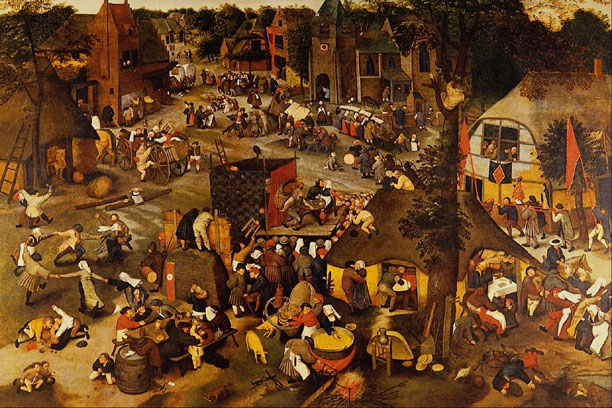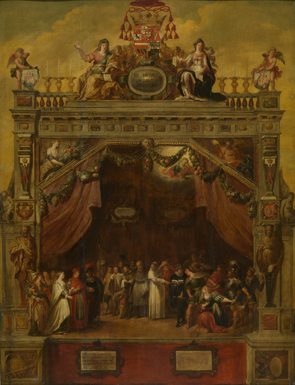 |
The Plays
 |
Spelen van zinne, literally "plays of the mind" but more often translated as "plays of meaning" or "theme plays" always had a didactic message at their heart. Plays might approach their subject matter either seriously or humorously. The most famous Rederijker play, Elckerlyc is better known by the name give to its English translation, Everyman. For many years the Dutch versus English origin of this play was hotly debated. However the matter was settled fairly well in 1939 when E.R. Twigg pointed out the way the English version has to add superfluous words and phrases to preserve the rhyme scheme established in the Dutch version as in the following:
Wilt
mi
vergheven mijn mesdade,
Want ic begheer aen u ghenade.
Forgyve
me my
gervous offence
Here I crye thy mercy in this presence.
Heir
in desen
aertschen leven
Die heylighe sacramenten seven.
Here
in this
transitory lyfe for thee and me
The blessed sacraments seven there be.
Elckerlyc won first prize in an Antwerp landjuweel around the year 1485. It is a highly allegorical and chronicles the journey of a character named "Everyman" through various personified temptations until he is eventually saved by the character Virtue.
The play perfectly illustrates the
typical
Rederijker approach to the audience that George  Kernodle
describes in "From Art to Theatre". He draws a
comparison between the way street theatres had sometimes changed
direct address to an honored noble into an action with a
character on stage representing that person to the way that the
creators of spelen van zinne instead of
directing a
sermon to the audience, metaphorically brought the audience on
the stage in the form of characters named "Youth," or
"Most Men," or "Mankind," or in the case of Elckerlyc,
"Everyman." The dramatist provided an advisor for the
audience stand-in, usually in the form of a character with a name
like "Spiritual Understanding," who would, via a
show-facade at the back of the stage, reveal a series of tableaux
to prove the play's argument. Plays of this type tended to
involve very little real action. They were closer to what
Kernodle aptly terms "illustrated lectures in
dialogue." There is even some debate among researchers as to
the extent to which painted backdrops were substituted for live
performers in non-speaking tableaux.
Kernodle
describes in "From Art to Theatre". He draws a
comparison between the way street theatres had sometimes changed
direct address to an honored noble into an action with a
character on stage representing that person to the way that the
creators of spelen van zinne instead of
directing a
sermon to the audience, metaphorically brought the audience on
the stage in the form of characters named "Youth," or
"Most Men," or "Mankind," or in the case of Elckerlyc,
"Everyman." The dramatist provided an advisor for the
audience stand-in, usually in the form of a character with a name
like "Spiritual Understanding," who would, via a
show-facade at the back of the stage, reveal a series of tableaux
to prove the play's argument. Plays of this type tended to
involve very little real action. They were closer to what
Kernodle aptly terms "illustrated lectures in
dialogue." There is even some debate among researchers as to
the extent to which painted backdrops were substituted for live
performers in non-speaking tableaux.
However, Everyman was not "everyplay." Click below for some contrasting examples of spelen van zinne:
Copyright © 1997 Kelly S. Taylor